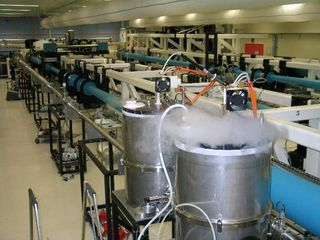November 20, 2007 feature
Axions Not Cause of Unexpected Observation

Scientists from France have shown that hypothetical axion-like particles cannot explain some unexpected observations in an Italian experiment carried out last year. Ruling out axions will likely subdue some of the renewed interest in axion searches, currently underway at several major institutions.
Researchers Cécile Robilliard et al., with group members from the Université Paul Sabatier Toulouse, the Centre National de la Recherche Scientifique, and École Polytechnique, have published their results in a recent issue of Physical Review Letters. The results invalidate the axion interpretation of the PVLAS optical measurements with a confidence level greater than 99.9%.
“If it were detected, the axion would be the first particle beyond the standard model, which would lead to a model crisis,” Robilliard told PhysOrg.com. “Besides, depending on its parameters, the axion might contribute to dark matter, which forms 25% of our universe.”
In 2006, the Italian collaboration PVLAS (Polarizzazione del Vuoto con LASer), designed to detect the optical non-linearity of quantum vacuum, made an unexpected observation. The team found that a magnetic field could generate a rotation of the polarization plane of linearly polarized light in a vacuum. The effect, called magnetic dichroism, is common but had never been observed in a vacuum and is not predicted by quantum electro-dynamics.
The PVLAS researchers suggested that axion-like particles, converted from photons in a process called the Primakoff effect, might explain the observation. But later, in June 2007, the PVLAS collaboration retracted their original observations, explaining that the observations were due to instrumental errors; after they upgraded their apparatus, the light rotation was no longer observed.
Nevertheless, the initial observation had already sparked new interest in the search for axion-like particles—light, neutral, spin-zero bosons that were first proposed 30 years ago to solve the strong-CP problem in particle physics, but never detected. Experiments to detect axions at DESY in Germany, CERN in Switzerland, Jefferson Laboratory in Virginia, and Fermilab in Illinois are currently under construction. For particle physicists, the CP problem is on the same order as the problem of beta decay in the 1930s, which led to the neutrino hypothesis. The neutrino wasn’t detected until two decades later, in 1956.
But Robilliard and her colleagues’ result may dampen some of the excitement. They have presented a photoregeneration experiment popularly called “light shining through a wall.” In the set-up, photons are converted into axion-like particles in a magnetic field. The photon beam is aimed at a 15-mm-wide aluminum wall, which blocks the photons, but allows any axion-like particles to pass through. In a magnetic field on the other side of the wall, the axion-like particles are converted back into photons and detected.
The main difficulty for this type of experiment lies in detection, since optical shielding needs to be perfect and detector background very low to achieve sensitive detection. The scientists overcame this challenge by using a pulsed laser and pulsed magnetic field in synchronization, enabling the single-photon detector to measure very small conversion rates. In contrast, most experiments use continuous lasers and magnetic fields, which is very demanding on the detector.
With this optimal detection apparatus, as well as optimizing other variables (such as the magnetic field length), the researchers didn’t detect any regenerated photons on the far side of the wall. Based on their calculations of the limits of the axion-like particle mass and the coupling of an axion-like particle with two photons, the researchers could exclude the possibility of axion-like particles in this model at greater than a 99.9% confidence level. In the future, they plan to improve their apparatus to achieve even more stringent limits on axion-like particles.
“My opinion is that, now that the PVLAS axion-like particle has been excluded by us with a confidence level better than three sigma, and the PVLAS collaboration has retracted their 2006 paper, the situation is the same as before the PVLAS 2006 results,” said Robilliard. “As far as I understand, there is no reason anymore to look for axion-like particles in the range of mass and coupling constant that have been already excluded by experiments like CAST or ADMX or by astrophysical observations.
“By contrast,” she added, “detecting the axion is still a major experimental challenge in particle physics.”
More information: Robilliard, C., Battesti, R., Fouché, M., Mauchain, J., Sautivet, A.-M., Amiranoff, F., and Rizzo, C. “No ‘Light Shining through a Wall’: Results from a Photoregeneration Experiment.” Physical Review Letters 99, 190403 (2007).
Copyright 2007 PhysOrg.com.
All rights reserved. This material may not be published, broadcast, rewritten or redistributed in whole or part without the express written permission of PhysOrg.com.





















